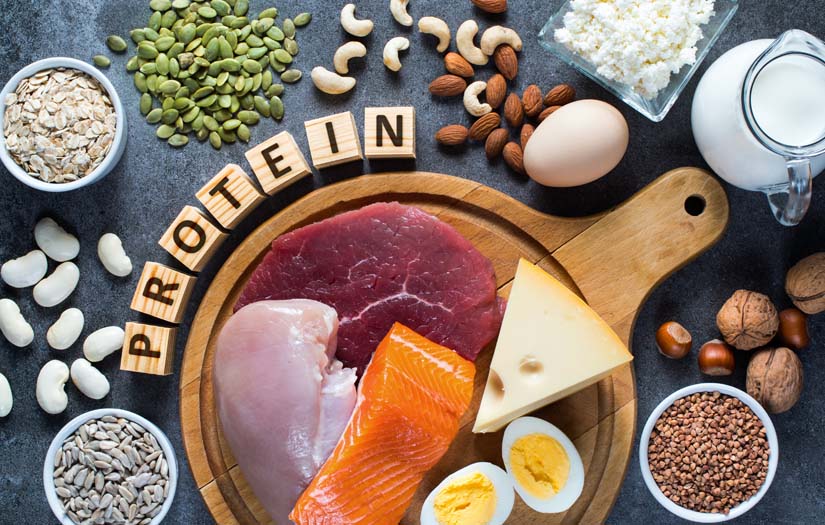Protein is an essential element in human nutrition; we can't go without it. Eating a diet that's rich in protein can help you build muscle, maintain healthy bones and tissues, regulate hormones, and maintain a healthy weight, but what does a protein-rich diet look like? Contrary to popular belief, a high-protein diet doesn't have to look like a whole bunch of meat and eggs.
There are benefits to eating a diet that consists of a wide variety of protein sources, including vegetable-based protein. In this article, we'll address some misconceptions when it comes to eating a protein-rich diet and we'll share some ways to incorporate alternative protein sources into your meal plan to help you boost your protein.
Want more info on all things protein? Read these NASM blogs.
Misconceptions About Getting Your Protein
"Eat more protein" is a common nutrition tip when it comes to maintaining a healthy weight, building muscle, and staying lean. But what does that mean? Let's address some common misconceptions when it comes to boosting your protein intake:
Misconception #1: High-protein diets are unhealthy and potentially even harmful.
The facts:
Most people can eat high-protein diets and not be concerned about negative health consequences. It's most important to consider the types of proteins that you are consuming. Choosing lean cuts of meats and low-processed options will deliver the most health benefits with the fewest associated health risks.
How much protein do you need? The general recommendation for protein intake is 0.8 – 2.2 grams of protein per kilogram of body weight per day (Trumbo et al., 2005; Pencharz et al., 2016). If you are less active, your protein needs will be lower. If you are more active or engaged in large amounts of vigorous exercise, your protein goals will fall on the higher end of the spectrum.
You can divide the total amount of protein that you need per day and divide it by the number of meals that you eat per day to help your meal plan. If you don't want to do the math, NASM has a free calorie calculator to help you find the right calories and macro balance for your goals and lifestyle.
Misconception #2: You must eat meat to get sufficient protein.
The facts:
Vegan and vegetarian sources of protein (like beans and lentils) can offer enough protein to meet daily requirements when paired with the right foods. Vegan or vegetarian sources of protein (except soy) are considered incomplete proteins because they do not contain all the essential amino acids in appropriate quantities.
To consume all the essential amino acids, vegan or vegetarian sources of protein must be paired with another complementary protein to meet these needs. By combining legumes with grains or nuts/seeds, you can meet your EAA needs and boost your protein intake. You don't have to eat these complementary proteins together in the same meal, either. You'll still get the nutrients that you need if you eat both types within the same day.
Whether you choose animal-based protein or vegetable-based protein, eating a variety of protein sources can help you boost your protein and get more nutrients that your body needs like: B vitamins, iron, magnesium, zinc, and EPA and DHA (omega-3 fatty acids).
5 Alternative Protein Options
Looking for protein sources that aren't your typical steak or chicken? Here are a few ideas to get you started:
• Greek Yogurt: Look for low-fat (2% or lower) and no sugar added. 1 cup of Greek yogurt can get you up to 20g of protein.
• Fish: Choose seafood that's higher in healthy fatty acids and lower in methylmercury such as salmon, anchovies, and trout. The recommended amount of fish is 8 ounces per week to get sufficient EPA and DHA.
• Nuts, Seeds, and Soy: Nuts and seeds are great to add to dishes for extra protein, healthy fats, and vitamins and minerals. They are more calorie dense, so limit each serving to ¼ cup. Soy products, such as tofu and tempeh, are versatile and are also complete proteins. One serving of tofu (1/2 cup of firm tofu) contains just over 21g of protein.
• Beans, Peas, and Lentils: These vegetables (yes, they're considered vegetables!) also pack a protein punch along with fiber and other nutrients. When combined with grains or nuts/seeds they provide a complete source of protein with all the needed essential amino acids. One serving is typically ½ cup cooked and can provide at least 8-12g of protein (depending on the type of legume you choose).
• Other Animal Protein Options: Instead of the typical beef, chicken, or turkey, try some other meat and poultry items. Lean pork, lamb, sliced deli meat (not the processed kind), Cornish hen, duck, or quail are some alternative options to add to your repertoire. You can also mix up the type of meat and poultry that you buy to add variety – choosing ground meat instead of a regular cut, for example.
Creative Ways to Incorporate Protein into Your Meal Planning
Looking for some simple, yet creative ways to boost your protein today? Mix it up! If you want to get more protein in your diet without just eating more animal protein, try adding legumes such as beans or lentils to add volume, protein, and nutrients to your plate. If you enjoy animal protein, try rotating the kinds of protein that you choose to vary your nutrients and prevent getting burnt out on the same thing (chicken and steamed broccoli again?!).
Easy Examples:
• Smoothies using Greek yogurt or protein powder with fruits, fresh greens, and even a little bit of avocado for some healthy fats.
• Hummus with veggies and/or whole wheat pita.
• Greek yogurt with berries or fruit.
• Tuna mixed with avocado (or mayo) served on bell pepper slices.
• Freshly sliced turkey rollup with sprouts and avocado slices in the middle.
Summary
Adding more protein to your diet doesn't have to be complicated or boring. If you're trying to incorporate more protein into your diet, but you can't handle another chicken breast, the good news is that you have many other options. Incorporating a wide variety of protein sources can help you boost your protein and add extra nutrients that your body needs to stay healthy and fit.
References:
Pencharz, P. B., Elango, R., & Wolfe, R. R. (2016). Recent developments in understanding protein need - How much and what kind should we eat? Applied Physiology, Nutrition, and Metabolism, 41(5), 577–580. doi:10.1139/apnm-2015-0549.
Protein foods (n.d.). MyPlate US Department of Agriculture. https://www.myplate.gov/eat-healthy/protein-foods
Trumbo, P., Schlicker, S., Yates, A. A., Poos, M., Food and Nutrition Board of the Institute of Medicine, & The National Academies. (2002, Nov.). Dietary reference intakes for energy, carbohydrate, fiber, fat, fatty acids, cholesterol, protein, and amino acids. Journal of the American Dietetic Association, 102(11), 1621–1630.

















